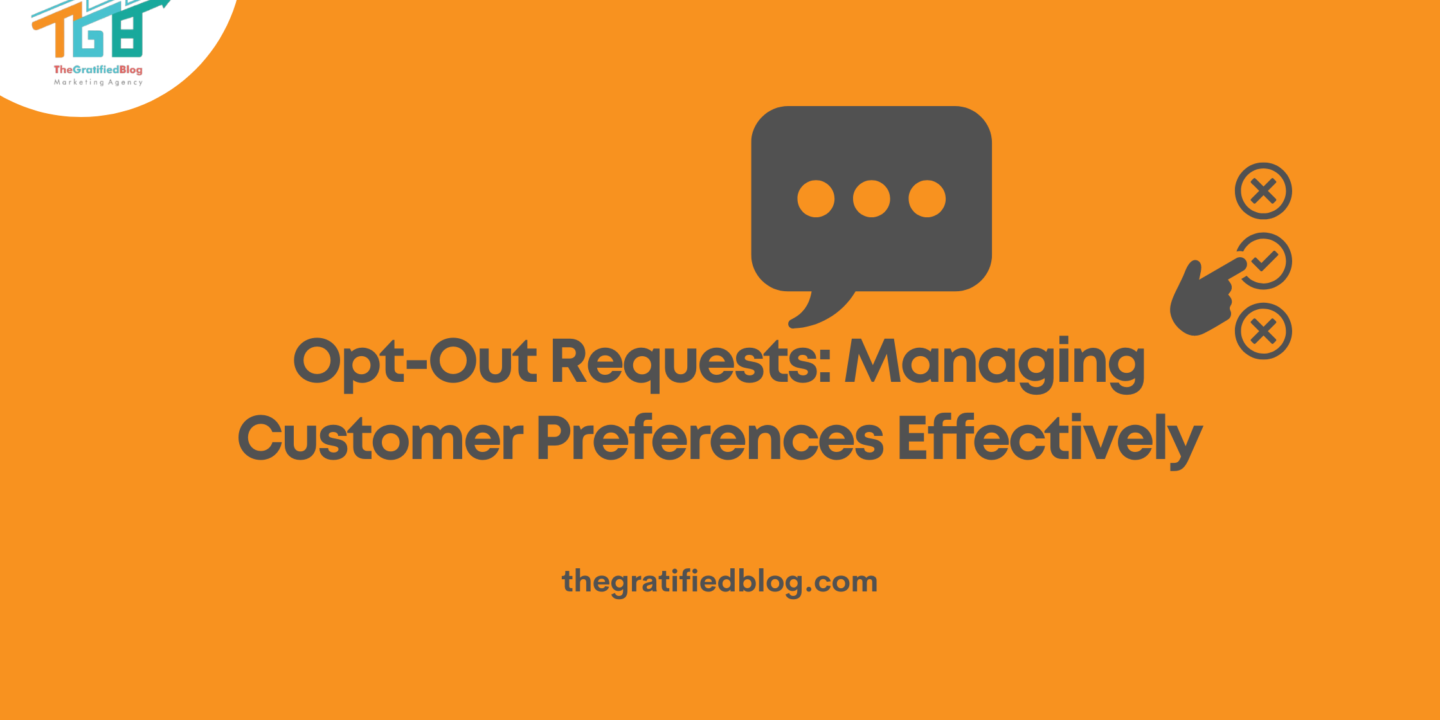
In digital communication, SMS marketing has emerged as a powerful tool for businesses to engage with their clientele. However, along with its benefits comes the responsibility to adhere to regulatory requirements and ensure customer satisfaction.
One critical aspect of SMS marketing compliance is effectively managing opt-out requests. This article Explores the importance of managing opt-out requests for compliance and customer satisfaction, providing valuable insights and strategies for businesses to implement.
Importance Of Managing Opt-Out Requests In SMS Marketing
It is crucial for several reasons:
- Legal Compliance: Following opt-out requests ensures compliance with regulations like (TCPA) and helps avoid potential legal consequences and fines.
- Respect for Privacy: Honoring opt-out requests demonstrates respect for individuals’ privacy preferences, fostering trust and maintaining a positive brand image.
- Improved Customer Experience: By allowing recipients to opt out, businesses show consideration for their preferences, improving customer satisfaction and loyalty.
- Cost Efficiency: Removing recipients who opt out helps streamline marketing efforts, ensuring resources are allocated effectively to engage with interested and receptive audiences.
- Reputation Management: Ignoring opt-out requests can result in negative feedback and damage the brand’s reputation, affecting future customer relationships and overall business success.
How Do We Balance Compliance With Regulations While Maintaining Customer Satisfaction?
Balancing compliance with laws and maintaining customer satisfaction is a delicate yet essential aspect of managing opt-out requests in SMS marketing. On one hand, businesses must adhere to lLegal obligations like the Telephone Consumer Protection Act (TCPA) and others to protect consumer Privacy and avoid potential penalties.
On the other hand, they must ensure that their opt-out process is seamless, respectful, and responsive to customer preferences, thereby preserving trust and loyalty. Achieving this balance requires careful consideration of regulatory guidelines, transparent communication with subscribers, and proactive measures to address opt-out requests promptly and efficiently.
By prioritising compliance and customer satisfaction, businesses can cultivate positive brand experiences while meeting legal obligations in their SMS marketing efforts.
Understanding Opt-Out Requests
Opt-out requests, commonly known as unsubscribe requests, refer to the explicit indications from Recipients to stop receiving communications via SMS. These requests are significant for several reasons. Firstly, they embody the principle of customer autonomy and choice, allowing individuals to control the frequency and nature of messages they receive.
Honouring opt-out requests is imperative for regulatory compliance, ensuring businesses adhere to laws such as the Telephone Consumer Protection Act (TCPA), A2P 10-DLC, and others. Failure to respect opt-out requests can result in legal ramifications, fines, and damage to reputation.
In the United States, the TCPA mandates that businesses must provide recipients with a clearand a readily available method to opt-out of receiving future SMS communications. A2P 10-DLC is there for companies to comply with text messaging regulations. These regulations demonstrate that a business is committed to following best practices and respecting customers’ preferences.
Failure to comply with these regulations, which may can result in substantial penalties and legal ramifications for businesses. Therefore, organisations must stay abreast of the changing legal landscape surrounding opt-out requests and ensure full compliance to mitigate potential risks.
Types Of Opt-Out Requests
encompass various forms, each with implications for communication strategies and customer engagement. The most common type is the unsubscribe request, where recipients explicitly request removal from a business’s SMS marketing list.
Additionally, there are opt-out requests related to specific preferences, such as the “do not disturb” option, where recipients may opt out of receiving messages during particular hours or for certain types of content. Understanding the nuances of these different types of opt-out requests enables businesses to tailor their communication approaches, respect customer preferences, and enhance overall satisfaction.
How Do We Create An Opt-Out Process For Efficiency And Accessibility?
Establishing an explicit opt-out mechanism is the cornerstone of a successful opt-out process in SMS marketing. This mechanism should be prominently featured in all communication materials, indicating how recipients can unsubscribe from further messages.
Ensuring opt-out options are easily accessible further enhances the user experience, reducing friction for individuals who wish to discontinue communication. Businesses can achieve this by prominently displaying opt-out instructions in SMS messages, on their website, and within customer service Interactions.
Providing multiple channels and custom opt-out keywords to request unsubscribe ensures recipients can opt-out using their preferred method. Additionally, automating opt-out processes streamlines operations, improves efficiency, and reduces the risk of human error.
By implementing automated systems to handle opt-out requests, businesses can ensure prompt and accurate processing while reallocating resources to concentrate on other facets of their SMS marketing campaigns. Overall, a well-designed opt-out process demonstrates respect for recipient preferences, fosters trust, and enhances the overall effectiveness of SMS marketing initiatives.
Mitigating Opt-Out Requests Through Effective Communication
Mitigating opt-out requests through effective communication, which is vital tor maintaining a healthy subscriber base and fostering positive relationships with your audience. Here are some strategies to achieve this:
Providing Valuable And Relevant Content To Subscribers
Make sure your email content provides value and pertinence to your subscribers’ interests and needs. Customize your content to target particular pain areas or interests of different segments of Regularly evaluate and improve your content strategy according to the needs of your audience engagement metrics and feedback from subscribers.
Segmenting Subscribers Based On Preferences And Interests
Use data analytics to segment your subscriber list based on demographics, behaviour, or preferences. Send targeted emails to each segment with content most likely to resonate with them. Continuously update and refine your segmentation strategy to ensure it remains effective over time.
Offering Opt-Down Alternatives
Provide subscribers the option to reduce email frequency or adjust their preferences instead of opting out altogether. Communicate the benefits of opting down, such as receiving valuable content with less frequency. Make the opt-down process simple and easy to navigate for subscribers.
Seeking Feedback From Opt-Outs To Improve Messaging
Reach out to subscribers who have opted out to understand their reasons. Use surveys or feedback forms to gather insights into what could be improved in your messaging or content. Act on the feedback received by making necessary adjustments to your email strategy to reduce opt-outs in the future.
Best Strategies For Increased Customer Satisfaction
Satisfied customers become loyal patrons and act as brand advocates, driving referrals and contributing to long-term profitability. To help businesses excel in these terms, here are some of the best strategies for increasing customer satisfaction:
Personalizing SMS Messages Based On Customer Preferences
Tailoring SMS messages to individual customer preferences can significantly increase engagement and satisfaction. Through the utilization of customer data and segmentation, businesses can transmit personalised messages that strike a chord with recipients, resulting in increased open rates and conversions.
Personalisation can include addressing customers by name, suggesting products or services according to previous buying history or browsing history, and sending targeted promotions or offers tailored to their interests.
Providing Opt-In Incentives To Encourage Engagement
Providing incentives to encourage customers to opt into receive SMS messages can effectively boost engagement and satisfaction. These incentives could include exclusive discounts, freebies, or access to VIP perks.
By clearly communicating the value proposition of opting in, businesses can incentivise customers to willingly subscribe to their SMS marketing campaigns. This can lead to a more receptive audience and higher satisfaction levels.
Offering Alternative Communication Channels For Customers Who Prefer Them
Recognizing that not all customers may prefer to communicate via SMS, businesses should offer alternative channels for those who have different preferences. This could include email, phone support, live chat, or social media messaging.
Providing multiple communication channels allows customers to select the approach that aligns most with their requirements and preferences, ultimately Increasing their satisfaction by offering flexibility and convenience.
Soliciting Feedback And Making Improvements Based On Customer Input
Actively seeking feedback from customers about their SMS marketing experience demonstrates a commitment to listening and responding to their needs. Businesses can solicit feedback through surveys, feedback forms, or simply by inviting customers to reply to SMS messages with their thoughts and suggestions.
By analyzing customer feedback and making continuous improvements to their SMS marketing strategy, businesses can ensure their messaging resonates with recipients and leads to greater satisfaction.
Conclusion
Effectively managing opt-out requests is crucial for businesses engaged in SMS marketing. By recognizing the significance of these requests for compliance with regulations, like the TCPA and A2P 10-DLC guidelines, businesses can navigate the complexities of SMS marketing successfully.
Implementing effective opt-out processes involves providing clear and easy-to-follow instructions for opting out, promptly honoring opt-out requests, and maintaining accurate opt-out lists. These actions not only ensure compliance with regulations but also demonstrate respect for customers’ preferences.








No Comments